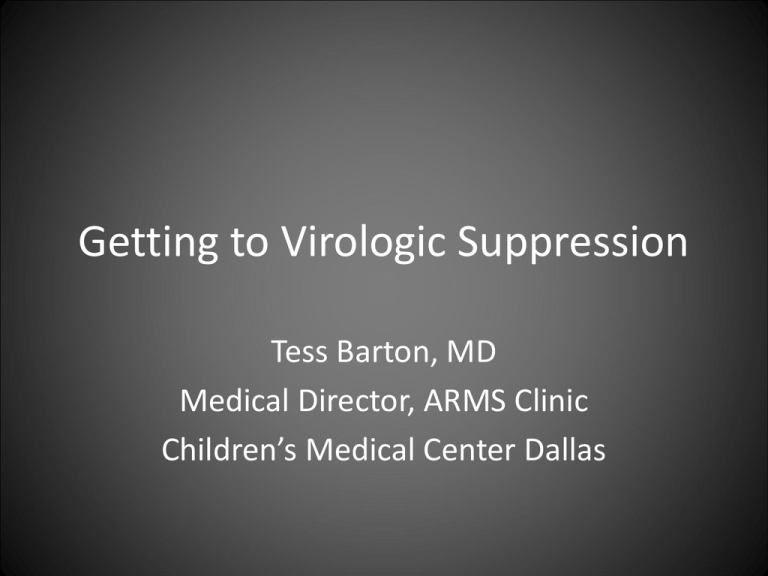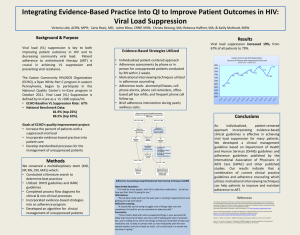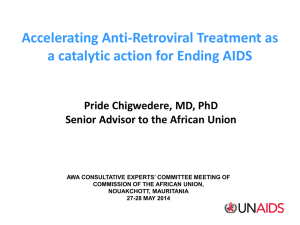
Getting to Virologic Suppression
Tess Barton, MD
Medical Director, ARMS Clinic
Children’s Medical Center Dallas
Diagnosis & Linkage to Care
Routine Medical Care &
Monitoring
HIV Treatment
Virologic Suppression
Improve
healthy survival
Reduce HIV
transmission
Timely appointments
available
Patient keeps
appointments
Diagnosis & Linkage to Care
Routine Medical Care &
Monitoring
Monitoring/screening is
done
Results/problems are
addressed
HIV Treatment
Virologic Suppression
Improve
healthy survival
Reduce HIV
transmission
Diagnosis & Linkage to Care
Medical Assessment for
Treatment
Routine Medical Care &
Monitoring
Patient Readiness
Assessed
HIV Treatment
Funding for Medication
Secured
Barriers to Adherence
Recognized
Virologic Suppression
Improve
healthy survival
Reduce HIV
transmission
Diagnosis & Linkage to Care
Routine Medical Care &
Monitoring
HIV Treatment
Resistance Testing to
Determine Best Regimen
Monitoring of Treatment
Labs
Virologic Suppression
Definition of Suppression
Adherence Assessment
Ongoing Funding
Improve
healthy survival
Reduce HIV
transmission
CMC Performance Measures
3 patients with <2 visits in 12
months
2 in process of moving
during reporting period
(both virologically
suppressed!)
1 truly not seen >6
months
38%??? How is
this possible?
Retention in Care
• Appointment Processes
– New patients
• Sources of most referrals: Health Dept, outside MDs, CMC
inpatient
• Direct phone contact between family + program coordinator
• Same day appointment available with MD (can see MD same
day of dx, if needed)
• Financial counseling done on arrival
– Existing patients
• Follow-up appointment made at time of checkout, provided
on written visit summary (most @ 3 month intervals)
• Pre-registration 3-7 days before appointment
• Phone call from program coordinator day before
• Program coordinator cell # available for teens – text
reminders PRN
Retention in Care
• Minimizing lost-to-care
– Missed appointments
• Same-day call from front desk or program coordinator
• Multiple team members with access to electronic scheduling
(minimal phone transfers)
• Telephone, email, Facebook, text msg, UTSW peers
• If unable to make contact in 2 weeks, certified letter sent
– Overdue appointments
• CareWare used to generate custom report of patients not
seen in >4 months
• Program coordinator + social worker contact these families
to make appointment
Retention to Care
• Unmeasurable Factors
– Personal touch
• Use of minimal personnel – family knows the person who is
calling
• Friendly atmosphere
– Hugs from MD, birthday treats, personal conversations
– Creating closer patient + team relationship
• Camps, teen group, parent support group, Facebook
– Availability
• Same-day appointments, sick visits, 24-hour on-call provider
• Personal contact
Retention to Care
• Challenges
– 20% no-show rate for each clinic session despite
efforts
• 3-month visits + vigilant chasing of no-shows leads to good
performance on HAB measure
– Staff effort/phone calls difficult to track and fund
• 10 phone calls/messages to get a patient to keep 1
appointment is not a billable or reimbursable service
• How much additional time is spent documenting
– Additional activities to create relationships requires
time + money
CMC Performance Measures
42/108 =
38%
Only 1 patient not seen in
>6 months
14/108 (13%) not on
treatment
Viral Suppression
• In+Care Campaign Measure: Retention Measure
4: Viral Load Suppression
– Percentage of patients, regardless of age, with a
diagnosis of HIV/AIDS with a viral load less than 200
copies/mL at last viral load test during the
measurement year
• Why?
– Critical link between efforts at medical care and
healthy patient survival
– Recent indication of viral suppression as means of
preventing transmission
VL Not Suppressed
• Not on treatment = 13%
(n=14)
– CD4 >500 = 7
– CD4 350-500 = 4
• 2 started on medications
after reporting period
• 1 transitioned to adult
care
• 1 disclosed in preparation
– CD4 <350 = 3
• all started on medications
after reporting period
VL Not Suppressed
• 27 had VL<200 within 6
months before/after
–
–
–
–
Blips
Assay variation
Re-suppression
Regimen change
• 25/94 (26%) treated
patients had VL <1000
– VL 200-500 = 16
– VL 500-1000 = 9
Low Level Viremia – E.R. Case
• 18 year-old male
• Tested HIV+ with blood donation 11/2010 12/2010 – received notification from Carter
BloodCare
• 12/16 – CMC ER visit to get evaluated – PCR
sent
• 12/21 – ARMS Clinic MD appointment to
discuss results
Virologic History
Date
Viral Load
CD4
December 2010
14,000
256
February 2011
12,000
329
March 2011
590
440
April 2011
950
July 2011
October 2011
340
410
History
Started Atripla
Always reporting
501
100%
adherence
Is the
lab assay
used at
576
Genotype
– all drugsof
susceptible
If purpose
treatment
PHHS different
than the healthy
is improved
one
usedLoses
byMedicaid;
CMC
(sent
Transfer
to Parkland
survival
andtoreduced
626
Young
Adult Clinic (Barton)
ARUP)?
transmission, am I
January 2012
<20
650
April 2012
<20
585
August 2012
<20
691
concerned about this
viral load?
VL Not Suppressed
•
38%
virologically
Chart Review of 62 nonsuppressed
suppressed
patients revealed
13%
not requiring
that 30 •had
adherence
problems
treatment
• 23% low level viremia,
or having blips
26% truly not virologically
suppressed
Adherence Problems
• Randomly chosen cases to present today:
• Patient A. – 17 y/o perinatal HIV
– VL 23,000; CD4 442
– Conflicts with dad over authority, sexual orientation
– Asserting independence, exploring autonomy –
medications not a priority for him
– Probable bipolar d/o, refusing treatment
– Solution: JobCorps, needs to mature, keep engaged
in care during uncertain living situation, reinforce
safe sex, wait
Adherence Problems
•
•
•
•
Patient B. – 11 year-old perinatal HIV
VL 1100, CD4 1209
Recently moved to Dallas area (labs were 2nd visit)
Recently disclosed, does admit to missed doses (mostly
forgotten)
• Mom with long hx non-adherence
• Solutions: CPS involved at time of transfer to Dallas,
reminders, enlisted help of nearby aunt to assist mom,
gave child task of reminding mom to take her own
medicines, enroll in summer camp for HIV+ kids
Adherence Problems
• Patient C. – 10 y/o perinatal HIV/AIDS, lowest CD4
190s, no AIDS illnesses
• Not disclosed, mom not ready
• Mom never adherent - recently hospitalized with PCP,
very ill; mom’s partner not aware of her HIV status
• Older HIV-negative brother recently learned mom,
brother HIV status
• VL 1100, CD4 914 (up from 200s 9 months ago)
• Solutions: CPS involved numerous times; mom and
patient clearly trying now; regimen recently optimized
for once-daily and reduced side effects; enlist help of
older brother; pressuring mom to allow disclosure
Adherence Problems
•
•
•
•
Patient D
. – 12 month perinatal HIV, asymptomatic
VL 49,000; CD4 24.1%
Mom in denial about HIV during pregnancy, still not in
care for herself; struggling emotionally with infant
infection
• After extended visit, she admitted to not giving infant
medications due to emotional distress – expressed
relief after confessing, and commitment to improving
• Next VL 870, CD4 43%
• Solutions: Continue to support mom, encourage her to
stay in care, frequent appointments (transportation
assistance needed)
CMC Performance Review
• How can CMC have 98% retention in care, but
only 38% virologically suppressed?
– Patients being brought into care, tracked closely,
monitored and assessed
– Partly related to inherent reporting flaws
• Single time point of dynamic value
• Denominator including untreated patients
– Nuances of viral load vs. clinical status – the art of
medicine
• Our barrier to VL suppression is not lack of
retention
Adherence barriers are
highly individualized
CMC Performance Review
• Areas for improvement
– Evaluation of VL assay
– ADHERENCE
Can make #s look prettier
Single solution
for reporting purposes
approach will not impact
with no real change in
overall suppression rate
patient care
Standardized
Confounding
issues of
• How often are adherence assessments
done?
adherence assessments
blood volume, cost
• How are adherence assessments
done?
are NOT the solution in a
setting where adherence
• Multifactorial solution
May investigate further
barriers are already being
– Mental health issues
to minimize provider
recognized
– Adolescent emotional development
frustration and patient
– Caregiver role
anxiety
– Treatment readiness
– Bribery?
Timely appointments
available
Patient keeps
appointments
Diagnosis & Linkage to Care
Routine Medical Care &
Monitoring
Monitoring/screening is
done
Results/problems are
addressed
✓
HIV Treatment
Virologic Suppression
Improve
healthy survival
Reduce HIV
transmission
Diagnosis & Linkage to Care
✓
✓
Medical Assessment for
Treatment
Patient Readiness
Assessed
Routine Medical Care &
Monitoring
HIV Treatment
Funding for Medication
Secured
Barriers to Adherence
Recognized
Virologic Suppression
Improve
healthy survival
Reduce HIV
transmission
Diagnosis & Linkage to Care
Routine Medical Care &
Monitoring
✓
✓
HIV Treatment
Resistance Testing to
Determine Best Regimen
Monitoring of Treatment
Labs
Virologic Suppression
Definition of Suppression
Adherence Assessment
Ongoing Funding
Improve
healthy survival
Reduce HIV
transmission
Questions?
Follow-up Project
• Attempted to arrange duplicate viral load
testing
– ARUP vs. Mayo
– Blood sent on 3, only able to obtain results for 1
– VL 230 vs 270
• County hospital tests remain <20 for those
transitioned patients
• Next step: Switch to county lab for 2-3 month
trial period
Follow-Up Data
• From 4/1/2011-3/31/2012
– InCare Viral Load Suppression Measure 50/108=46.3% (this
is the measure we currently use in the Regional Group)
– Viral Load Suppression for those clients who are on ARVs
(all ages): 47/88=53.41%
– Viral Load Suppression for those clients who are on ARVs
and below 13 yrs: 24/35= 68.6%
– Viral Load Suppression for those clients who are on ARVs
and 13 yrs and older: 23/53=43.4%
– Viral Load Suppression for all ages using the new HAB
measure indicator definition: 46/84=54.8%





